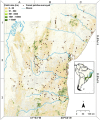Pervasive defaunation of forest remnants in a tropical biodiversity hotspot
- PMID: 22905103
- PMCID: PMC3419225
- DOI: 10.1371/journal.pone.0041671
Pervasive defaunation of forest remnants in a tropical biodiversity hotspot
Abstract
Tropical deforestation and forest fragmentation are among the most important biodiversity conservation issues worldwide, yet local extinctions of millions of animal and plant populations stranded in unprotected forest remnants remain poorly explained. Here, we report unprecedented rates of local extinctions of medium to large-bodied mammals in one of the world's most important tropical biodiversity hotspots. We scrutinized 8,846 person-years of local knowledge to derive patch occupancy data for 18 mammal species within 196 forest patches across a 252,669-km(2) study region of the Brazilian Atlantic Forest. We uncovered a staggering rate of local extinctions in the mammal fauna, with only 767 from a possible 3,528 populations still persisting. On average, forest patches retained 3.9 out of 18 potential species occupancies, and geographic ranges had contracted to 0-14.4% of their former distributions, including five large-bodied species that had been extirpated at a regional scale. Forest fragments were highly accessible to hunters and exposed to edge effects and fires, thereby severely diminishing the predictive power of species-area relationships, with the power model explaining only ~9% of the variation in species richness per patch. Hence, conventional species-area curves provided over-optimistic estimates of species persistence in that most forest fragments had lost species at a much faster rate than predicted by habitat loss alone.
Conflict of interest statement
Figures




References
-
- Millennium Ecosystem Assessment (2005) Ecosystems and Human Well-Being: Current State and Trends. (Island Press, Washington, DC).
-
- Brooks T, Tobias J, Balmford A (1999) Deforestation and bird extinctions in the Atlantic forest. Animal Conservation 2 3:211–222.
-
- Brooks TM, Mittermeier RA, Mittermeier CG, Fonseca GAB, Rylands AB, et al. (2002) Habitat loss and extinction in the hotspots of biodiversity. Conserv Biol 16 4:909–923.
-
- Peres CA (2001) Synergistic effects of subsistence hunting and habitat fragmentation on Amazonian forest vertebrates. Conserv Biol 15 6:1490–1505.
Publication types
MeSH terms
LinkOut - more resources
Full Text Sources
Other Literature Sources

